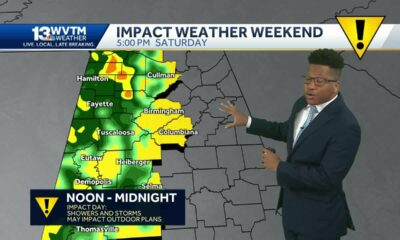Mississippi News
In ‘South to America,’ Imani Perry seeks to understand a region ‘so varying it can seem endless’
In ‘South to America,’ Imani Perry seeks to understand a region ‘so varying it can seem endless’

Imani Perry’s argument in “South to America” will feel familiar to any Southerner, or to anyone at all, who has ever been startled by the cheerful dismissals of the region you sometimes encounter elsewhere in the United States. “I’d never want to go to the South,” people up north have said when I told them where I’m from, as if it is a singular place uniformly deserving of disinterest or contempt. Perry, a native of Birmingham, Ala., argues that this tendency to treat the South – and especially its brutal history of racist exploitation and violence – as excisable from the rest of the country is a convenient fantasy.
The argument will also be familiar to anyone who has read much about the modern history of “the South” — a label that can sometimes feel more theoretical than lived, given the diversity of the place. As Perry writes, “The South is so varying it can seem endless. And yet you will still know ‘Southern’ means something over and against other regions.”
Writers’ journeys here are often a quest to understand our under-examined, intentionally obscured or distorted history, from Tony Horowitz’s “Confederates in the Attic” (a book Perry criticizes for its softness on white Confederate re-enactors and their devotion to Lost Cause mythology) to Clint Smith’s recent “How the Word is Passed.” Perry is a professor of African American studies at Princeton University and author of books on Lorraine Hansberry and the Black National Anthem, and she is very clear about the tradition she follows: “South to America” was directly inspired by Albert Murray’s book “South to A Very Old Place,” first published in 1971.
Murray was born and raised in Mobile and educated at Tuskegee University before moving to New York and making a career as an essayist, novelist and critic. During and after the civil rights movement, as Black writers and intellectuals debated whether the path forward was separatism or integration, Murray argued for the centrality of Black culture to American culture, and the unworkability of Black nationalism.
When “South to A Very Old Place” was published, the civil rights movement had wrought massive changes across the country, but their full significance was unclear. And though civil rights leaders had long highlighted the segregation and economic marginalization that characterized Black life in northern cities, the boundaries of the South were perhaps not as blurry as they are today.
Perry’s view of the South as synecdoche-of-sorts for America feels salient in 2022. We remember the Confederate flag hoisted in the U.S. Capitol – a scene never witnessed during the Civil War – on Jan. 6. The man who carried it was from Delaware, a slave state that remained in the Union, though that fact is perhaps unimportant in an era when the Confederate flag flies across the country, no longer always or even often purporting to represent “southern pride.”
Lawmakers in Wisconsin and Arizona join Georgians and Texans in plotting new ways to limit suffrage. The religious right, rooted in Southern evangelicalism, is ascendant. In the days after the Supreme Court’s ruling in Dobbs v. Jackson Women’s Health Organization, the battle-worn and exhausted clinic escorts, helping the final patients make it to their appointments before the clock ran out on legal abortion in the state, repeated some version of a bitter line: “Welcome to Mississippi, America.”
The southernization of American political life may also help explain why parts of Perry’s journey, 50 years after Murray’s, trigger similar reflections. In Atlanta, Murray visits a restaurant and is served uneventfully by a young white waitress. He thinks about what she would say if, say, Newsweek interviewed her about desegregation. He wouldn’t be surprised if she told them how “a white girl shouldn’t have to serve Negroes, and all that crap.” But then he asks: “Is what she says when interviewed on desegregation as a specific issue really more significant than the way she is acting right now with me sitting here?”
At the Nashville airport, Perry approaches a vending machine and realizes a white man is waiting to restock it. “You can g’on and get you something,” he tells her, smiling. Perry thinks that based on his demographics, “the odds are he wouldn’t feel so warmly about me,” and that she would likely be “irked by the things he thinks about the world.” And yet there is still “the softness with which we could speak to one another.” “Whatever it is that I’m saying about the South as America includes that too.” A point that was optimistic in 1971 now feels nearly tragic.
Murray beautifully rendered the speech of southerners, especially Black southerners in his hometown and from his university days at Tuskegee. Entire pages are filled with lengthy quotes from people he just let talk and talk. He compares the voices taking turns during a living room chat to a jazz ensemble. Perry seems to have spoken to fewer people, and her conversations with people she meets for the first time on her journey – as opposed to people she has long known as family friends or fellow writers – are often short. Their significance is sometimes derived from a heavy dose of speculation, like when a Lyft driver in Virginia becomes a symbol of toxic white evangelicalism after a strange but apparently brief exchange.
Perry notes that her politics are quite different from those of Murray, who believed in an American identity built through all of its constitutive parts: a “nation of multi-colored people.” (When Toni Morrison reviewed “South to a Very Old Place” for the New York Times in 1972, she criticized his disinterest in “the Afro part of Afro-Americans:” “The history of black Americans neither begins nor ends in Mobile, Ala.; its true meaning will stay hidden from any black who does not know that there is another place even Souther and much, much older.”)
Perry instead draws connections between the Black South and the larger Black diaspora. In addition to 12 states and the District of Columbia, she travels to the Bahamas and Havana to show the historical and cultural linkages between the South and the Caribbean, and to gain perspective through distance. “We say the only difference between Black folks in various parts of the diaspora is where the boat stopped, but we don’t say that the boats, and the marches through land, didn’t ever stop…. There are rhythms that would be found here and there, though a different blend. This is, I think, the thing that Albert Murray got wrong about the South, even as he described those rhythms with a seriousness and a precision unlike anyone before and likely since.”
In Mississippi, Perry focuses on the city of Jackson, highlighting the historical ironies that surround those of us who live here to such a degree that we sometimes become inured to them. Jackson, Perry writes, “is part Chicago and mostly Mississippi, a place where, like the first Chokwe Lumumba, people reverse-migrate, either to start a revolution or because life in the North was too cold.”
She describes the history of the New Afrikan People’s Organization, for which Lumumba was vice president, with “the goals of self-determination, land ownership, and an independent nation-state for New Afrikans” in Louisiana, Mississippi, Alabama, Georgia and South Carolina. Though the Black Power movement is often conceptualized as non-Southern, she points out that it is a Deep South capital that is led by a “scion of Black nationalism,” the younger Chokwe Lumumba. And Jackson, “unapologetically Black,” is the capital of the state with the country’s largest Black population and largest number of Black elected officials, and home to two Historically Black Colleges and Universities (Perry vividly describes the Sonic Boom of the South marching through the city streets). All this in the American state most synonymous with violence and murder in the name of white supremacy.
Yet today the life expectancy for Black men in Mississippi is less than 67 years. Perry mentions, too, the Central American and Mexican poultry factory workers detained by U.S. Immigration and Customs Enforcement in the largest raids in history.
“We haven’t outrun or outlived the plantation, although it looks a little bit different… There’s an honesty to Mississippi about all of this. The triumph is not in ends, it is in the fact that we are still here.”
Perry is a featured panelist at the Mississippi Book Festival on Aug. 20.
This article first appeared on Mississippi Today and is republished here under a Creative Commons license.
Mississippi News
Ole Miss women get pair of double-doubles and roll to 83-65 March Madness win over Ball State
SUMMARY: Mississippi coach Yolett McPhee-McCuin found solace in returning to a different arena in Waco, Texas, following a disappointing previous tournament experience. The No. 5 seed Ole Miss Rebels redeemed themselves with an 83-65 victory over 12th-seeded Ball State in the NCAA Tournament’s first round. Starr Jacobs led the Rebels with 18 points and 11 rebounds, while Kennedy Todd-Williams and Madison Scott each scored 15 points. Ole Miss dominated rebounding, leading 52-32, and will face fourth-seeded Baylor next. Coach McPhee-McCuin noted the team’s evolution since their last visit and the significance of playing in Texas, where Jacobs feels at home.
The post Ole Miss women get pair of double-doubles and roll to 83-65 March Madness win over Ball State appeared first on www.wjtv.com
Mississippi News
Events happening this weekend in Mississippi: March 21-23
SUMMARY: This weekend (March 21-23), Mississippi offers a range of exciting events. Highlights include Hal’s Marching MALfunction Second Line Stomp and Jessie Robinson’s blues performance in Jackson, as well as the Natchez Food & Wine Festival and the Natchez Little Theatre’s production of *This Side of Crazy*. There are also numerous exhibitions like *Of Salt and Spirit: Black Quilters in the American South* in Jackson and *Gold in the Hills* in Vicksburg. Other events include the 48th Annual Crawfish Classic Tennis Tournament in Hattiesburg, karaoke nights in Laurel, and a variety of family-friendly activities across the state.
The post Events happening this weekend in Mississippi: March 21-23 appeared first on www.wjtv.com
Mississippi News
Events happening this weekend in Mississippi: March 14-16
SUMMARY: This weekend (March 14-16) in Mississippi offers a variety of events. In Jackson, iconic saxophonist Boney James performs at the convention center, while the JXN Food & Wine festival showcases culinary talents. The LeFleur Museum District hosts a “Week of Wonder,” and several exhibitions, including “Of Salt and Spirit,” celebrate Black quilters. Natchez features the Spring Pilgrimage tours, a reenactment of Annie Stewart’s story, and a St. Patrick’s Day celebration. In Hattiesburg, comedian Rob Schneider performs, and various events like a St. Patrick’s Day pub crawl and a talent show will take place throughout the area.
The post Events happening this weekend in Mississippi: March 14-16 appeared first on www.wjtv.com
-

 News from the South - Florida News Feed7 days ago
News from the South - Florida News Feed7 days agoFamily mourns death of 10-year-old Xavier Williams
-

 News from the South - Alabama News Feed6 days ago
News from the South - Alabama News Feed6 days agoSevere storms will impact Alabama this weekend. Damaging winds, hail, and a tornado threat are al…
-

 Mississippi Today16 hours ago
Mississippi Today16 hours agoPharmacy benefit manager reform likely dead
-

 News from the South - Alabama News Feed5 days ago
News from the South - Alabama News Feed5 days agoUniversity of Alabama student detained by ICE moved to Louisiana
-

 News from the South - Louisiana News Feed7 days ago
News from the South - Louisiana News Feed7 days agoSeafood testers find Shreveport restaurants deceiving customers with foreign shrimp
-

 News from the South - Oklahoma News Feed4 days ago
News from the South - Oklahoma News Feed4 days agoTornado watch, severe thunderstorm warnings issued for Oklahoma
-

 News from the South - West Virginia News Feed7 days ago
News from the South - West Virginia News Feed7 days agoRoane County Schools installing security film on windows to protect students
-

 News from the South - Virginia News Feed5 days ago
News from the South - Virginia News Feed5 days agoYoungkin removes Ellis, appoints Cuccinelli to UVa board | Virginia


















































